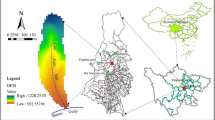Abstract
Debris flow disasters are usually accompanied by serious loss of lives and properties. However, debris flows are also part of earth’s natural phenomenon, and so what is the reasonable budget to be spent on mitigation measures becomes an important issue for the budget allocation processes. This article utilizes economic concepts to propose a reasonable estimation of the hazard damage and the cost of proposed mitigation measures. The proposed method is composed of four steps, namely, delineating the area of the disaster with different return periods, itemizing the land use within those areas, calculating the hazard loss using official values, and computing the expected probable maximum loss with a probability distribution. The comparison between the assessment of hazard and the economic gains of any proposed mitigation measures can be used as a reference for future decision-making process.













Similar content being viewed by others
References
Breaden JP (1973) The generation of flood damage time sequences. University of Kentucky Water Resources Institute Paper, No. 32
Chua KT, Lo KH (2004) Hazard assessment of debris flow for Leung King Estate of Hong Kong by incorporating GIS with numerical simulations. Nat Hazards Earth Syst Sci 4:103–116
Council for Economic Planning and Development (2004) The investigation of typhoon aere and strategy for recovery. pp 5-7–5-9
Fisher A, Violette D, Chestnut L (1989) The value of reducing risks of death: a note on new evidence. J Policy Anal Manag 8(1):88–100. doi:10.2307/3324426
Freeman AM III (1993) The measurement of environmental and resource values. Theory and methods. Resources of the Future, Washington, DC
Grigg NS, Helweg OJ (1975) State-of-the art of estimating flood damage in urban areas. Water Resour Bull 11(2):379–390
Grigg NS, Botham LH, Rice L, Shoemaker WJ, Tucker LS (1976) Urban drainage and flood control projects economic, legal and financial aspects. Hydrology Paper, Colorado State University, Fort Collins, Colorado
Hicks J (1946) Value and capital: an inquiry into some fundamental principles of economic theory. Clarendon Press, Oxford
Julien PY, Lan Y (1991) Rheology of hyperconcentrations. J Hydraul Eng ASCE 117:346–353. doi:10.1061/(ASCE)0733-9429(1991)117:3(346)
Laigle D, Marchi L (2000) Example of mud/debris-flow hazard assessment, using numerical models. Debris-flow hazard mitigation: mechanics, prediction, and assessment. Proceedings of international conference, Taipei, pp 417–424
Lee CH (2006) Household debris-flow disaster damage assessment in Taiwan. Master’s thesis in Institute of Natural Resource Management, National Taipei University
Lin GF, Chen LH, Lai JN (2006) Assessment of risk due to debris flow events: a case study in central Taiwan. Nat Hazards 39(1):1–14. doi:10.1007/s11069-005-1922-x
Liu KF, Huang MC (2006) Engineering planning of debris flow protection measure with numerical simulation. Eng Geosci 10:221–240
Liu JT, Hammitt JK, Liu JL (1997) Estimated hedonic wage function and value of life in a developing country. Econ Lett 57:353–358
Lorenzo M, Vincenzo D (2004) Estimation of debris flow magnitude in eastern Italian Alps. Earth Surf Process Landf 29(2):207–220
Monthly Bulletin of Statistics (2005) Directorate-General of budget, accounting and statistics, vol 420. Executive Yuan, R.O.C.
National science and technology Center for Disaster Reduction, NCDR (2005) Study on the design of debris flow hazard magnitude for non-structure strategy in Taiwan. pp 183–185
Shih BJ, Jern KY, Shieh CL, Chen LJ (1997) A study on the hazardous debris flow zoning. Proceedings of the 1st national debris flow conference, Taiwan, pp 141–155
Staffler H, Berger E, Zischg A (2006) Localization and assessment of potential damages in settlements and infrastructures caused by floods and debris flow as a decision basis for the prioritization of mitigation measures. Geophys Res Abstr 8:03308
Takahashi T (1980) Debris flow on prismatic open channel. J Hydraul Div ASCE 106(HY3):381–396
Talanov EA (2007) Regional assessment of ecological and economic risk of water erosion and debris flows. Almaty, 352 pp (in Russian)
Tsai CT, Yu PS (1994) GIS system applied in flood disaster II. Department of Hydraulic and Ocean Engineering of National Cheng Kung University
Tsai CT, Yu PS (1995) GIS system applied in flood disaster III. Department of Hydraulic and Ocean Engineering of National Cheng Kung University
Xue LM, Wang SW (1987) Estimation of the value of life for employed workers in Taiwan: a wage-risk approach. Ching chi chuan lun, No. 108
Acknowledgment
This research is supported by National Science Council, Taiwan.
Author information
Authors and Affiliations
Corresponding author
Rights and permissions
About this article
Cite this article
Liu, KF., Li, HC. & Hsu, YC. Debris flow hazard assessment with numerical simulation. Nat Hazards 49, 137–161 (2009). https://doi.org/10.1007/s11069-008-9285-8
Received:
Accepted:
Published:
Issue Date:
DOI: https://doi.org/10.1007/s11069-008-9285-8




